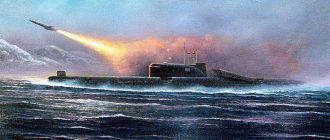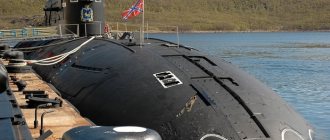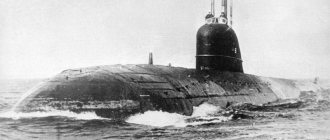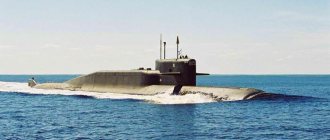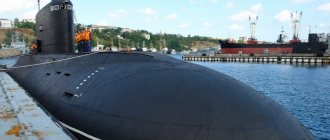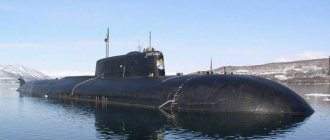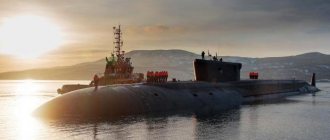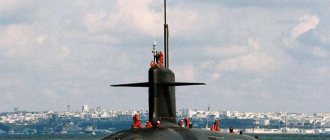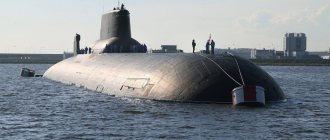The Yasen submarine (project 885) is the most modern and most expensive Russian nuclear-powered multi-purpose submarine of the fourth generation. So far, only one submarine of this series has been launched - in 2022, the lead ship of the Severodvinsk project joined the Northern Fleet.
Today, there are five more Project 885 submarines on the Sevmash stocks: Kazan, Novosibirsk, Krasnoyarsk, Arkhangelsk and Perm. All of them will be built according to an improved design - 885M.
The development of this project was carried out by the designers of the Malachite SPMBM.
Project 885 is the Russian response to the American nuclear submarines SeaWolf and Virginia. Initially, it was planned to build 30 Yasen submarines; currently the Russian Navy expects to receive 7 ships of this project by 2022.
The Yasen nuclear submarine is one of the most secret projects of the Russian military-industrial complex: any filming in the workshops of the Northern Engineering Enterprise, where the ships are assembled, is strictly prohibited. And this is not surprising: “Ash” is called the most advanced project of Russian military shipbuilding. For example, if in the latest fourth-generation submarine missile carriers of the Borei type (Project 955) the equipment used for the first time is approximately 40%, then in the Kazan nuclear submarine almost all systems, components and mechanisms have never been used anywhere before.
In addition, Project 885 submarines are called the most expensive ships of the Russian Navy. There is information that the cost of the first of the Yasen series of submarines is 47 billion rubles (2015). Although, such amounts are quite comparable to what a potential enemy spends on the submarine fleet: the price of one American Sea Wolf is approximately $4.4 billion.
Project 885 submarines are the quintessence of all the experience that the domestic military-industrial complex has gained over half a century of creating and operating nuclear submarines.
History of creation
Since the first nuclear-powered submarine, the Nautilus, went to sea in 1955, submarine shipbuilding has become a major area of competition between the United States and the Soviet Union. The installation of a nuclear reactor on a submarine increased the combat characteristics of this type of ship so much that they turned into real “masters of the oceans.” In the USSR, submarines became the main force of the navy for many decades.
The importance of nuclear submarines increased even more after they were equipped with ballistic missiles. After that, they became part of the nuclear triad, and its most dangerous component.
The exact coordinates of all silo launchers of intercontinental ballistic missiles have long been known; interceptors and air defense systems make strategic bombers an ineffective means of delivering nuclear weapons, but try to detect a submarine armed with ballistic missiles in the vast expanses of the World Ocean. It’s not for nothing that nuclear submarines are called “city killers.”
The development of the nuclear submarine fleet in the USA and the USSR followed slightly different paths. In the United States, Admiral Human Rickover is considered the “father of the nuclear fleet.” This man strictly controlled all stages of the design and construction of submarines, harshly rejecting all parallel projects that he considered unpromising and unnecessary. The result of this policy was a simple, harmonious and unified line of development of the American submarine fleet and, as a result, a small number of types of submarines that are in service with the US Navy.
In the Soviet Union the situation was the opposite. There were three design bureaus that were involved in the design of nuclear submarines: “Malachite” and “Rubin” (Leningrad) and Gorky’s “Lazurit”. These design bureaus competed with each other and proposed various projects for strategic and multi-purpose submarines to the country's leadership, which ultimately led to the use of a large number of different types and modifications of submarines by the USSR Navy. This greatly complicated their operation and maintenance. And of course, it made them many times more expensive.
In the mid-70s, the USSR Navy received several third-generation nuclear submarines at once. Soviet designers finally managed to get closer to American submarines in terms of stealth characteristics (most important for a combat submarine).
In 1977, work began on creating the appearance of the next, fourth generation submarine. All three design bureaus received the task of designing a new ship. "Rubin" worked on a submarine with anti-ship cruise missiles, "Lazurit" - on a specialized anti-submarine nuclear submarine, and the designers of the Malachite Design Bureau began developing a multi-purpose submarine, which eventually received the name "Ash".
However, later the military made a truly revolutionary decision: to combine all three projects into one and create the first domestic multi-purpose submarine. Its main reason was the constant increase in the cost of submarines from generation to generation. The “Malachite” “Ash” was chosen as the basic project for creating a new ship.
The designers were given a difficult task, so the timing of the design work was delayed. They were completed only by the beginning of the 90s, but at that time the possibility of building a new revolutionary ship was called into question.
Despite all the economic difficulties, the new submarine was solemnly laid down at Sevmashzavod on December 21, 1993. It is symbolic, but the Severodvinsk nuclear submarine is the first warship laid down in modern Russia.
The launch of this boat was planned for 1996, but in reality everything turned out completely differently. The first "Ash" became a long-term construction project. Due to lack of funding, work on the submarine was completely stopped in 1996. At the beginning of the 2000s, when attention was paid to the project again, it turned out that many elements of its equipment were already obsolete, so the project had to be seriously adjusted. In addition, difficulties arose with old suppliers, who now found themselves in other states, or even simply ceased to exist.
Only in 2004 did work continue on the modified project. On June 24, 2010, the boat was finally launched. The following year, she went to sea for factory tests, which, together with modifications, took three years. At the same time, work and testing of the Onyx and Caliber cruise missiles, the main weapons of the future warship, were underway. Only on July 17, 2014, the nuclear submarine Severodvinsk was accepted into the Northern Fleet.
It took more than twenty years to build the first Project 885 ship.
The second submarine of this project was laid down on July 24, 2009, and was named Kazan. The second and subsequent ships of the project will be built according to the modernized Yasen-M project. They will differ from the basic one by more advanced equipment, a modified shape of the ship's hull contours and an even greater reduction in noise level. In addition, the second and all subsequent Project 885 boats will be built exclusively by Russian enterprises. It was decided to refuse suppliers from the former Soviet republics.
On July 26, 2013, the third boat of the project, Novosibirsk, was laid down. It is planned to be put into operation in 2020.
The fourth submarine of Project 885 “Krasnoyarsk” was laid down on July 27, 2014.
The fifth submarine "Arkhangelsk" was laid down on March 19, 2020.
On July 29, 2022, the sixth submarine of the Perm project was laid down at Sevmashzavod.
Cost of SSGN "Ash"
Boats of the Yasen-M project are expected to have quite significant differences in the amount of expenditure for construction work. Despite the fact that they are built according to the same project, each subsequent submarine is different from all previous ones. Designers and engineers are in constant search of improving the tactical and technical characteristics of ships. First of all, this concerns:
- avionics;
- combat control information system;
- main power plant;
- weapons.
The cost of the lead boat of the Yasen project (K560 Severodvinsk) is 47 billion rubles. The K-561 “Kazan” (project “Yasen-M”) has comparable consumables figures. But it has more advanced anti-noise equipment and different body contours.
The military department and intelligence are constantly working on the problem of leaking classified technical information. This was the reason for complete import substitution during the construction of the Yasen-M SSGN. Absolutely all materials, components and equipment are made in Russia.
Unique technologies and team guarantee the success of the Yasen-M project
The cost of subsequent boats of the project should be consistently reduced due to the improvement of the technological construction cycle and the use of more advanced technologies and new developments. Similar trends can be observed in the construction of direct competitors.
The approximate cost of American multi-purpose submarine cruisers has also dropped by almost half over ten years:
- Seawolf class nuclear submarine - $4.7 billion;
- Virginia class nuclear submarine - $2.7 billion.
Description of design
As mentioned above, Project 885 “Ash” is one of the most secret in the Russian military-industrial complex. For a long time, this served as the reason for numerous guesses and very bizarre fantasies regarding the new ship. For the first time, images of this submarine appeared in the Gangut magazine in 1998. However, even today there is little accurate information about the equipment installed on the new submarine, although its main characteristics are known.
Project 885 “Ash” inherited many of the signature features of previous submarines designed at the Malachite Design Bureau: a streamlined teardrop-shaped hull and a characteristic ship’s wheelhouse fencing. However, the internal layout of the submarine was in many ways an exception to the traditions of Soviet submarine shipbuilding.
Most Soviet nuclear submarines had a double-hull design. That is, they had a durable body, which was located inside the lung, and ballast tanks were located between them. The naval leadership insisted on this design, believing that submarines built according to this design have a greater buoyancy reserve.
However, such a submarine design also has serious drawbacks: the double-hull design negatively affects the stealth of the nuclear submarine. In this case, the lightweight hull plays the role of a kind of resonator and significantly increases the noise of the submarine in the low-frequency range. It is for this reason that the Americans long ago abandoned such a scheme and built their submarines with one hull, placing ballast tanks directly in it.
Project 885 Yasen nuclear submarines have a compromise one-and-a-half-hull design: a lightweight hull covers a strong one only in the bow of the ship and above the superstructure in the area of the missile silos.
The boat is made according to a single-shaft design; the submarine's hull is made of high-strength low-magnetic steel. Project 885 Yasen nuclear submarines are equipped with a low-noise propeller with seven blades of a special saber shape.
The submarine's crew consists of 90 people, of which 32 are officers.
Another design solution, unusual for the Soviet school of underwater shipbuilding, was the placement of a large spherical antenna of the Amphora hydroacoustic station in the bow of the submarine. It is the most important part of the new generation hydroacoustic complex “Irtysh”. The spherical antenna has a large number of sensitive detectors, and its location provides the best conditions for its operation. The unusual situation is that due to the placement of the antenna, the torpedo tubes, which were traditionally located in the bow compartment on Soviet nuclear submarines, had to be removed from the bow of the boat.
On the Ashes they are moved to the middle part of the ship and located at an angle to the center plane of the boat. Such an arrangement has been used in the American submarine fleet for more than forty years, but was always rejected by the USSR Navy, because with such an arrangement of torpedo tubes when firing, the boat should significantly reduce its speed.
According to other data, in addition to the Irtysh hydroacoustic complex, Project 885 boats will be equipped with an Ajax hydroacoustic complex, with antennas located throughout the entire area of the ship’s hull. It is likely that submarines of this project will also have a towed low-frequency antenna extending from the top of the rudder.
Another “highlight” of Project 885 submarines is their power plant. The submarines will receive a new generation pressurized water nuclear reactor, which will significantly increase the reliability of the power system of the nuclear submarine of the Yasen project. The reactor has an integrated layout circuit; the primary coolant pipelines are located directly in its body. Experts believe that the service life of such a reactor will be 25-30 years, which is comparable to the normal operating time of the submarine itself.
This design of the submarine’s nuclear reactor significantly reduces the likelihood of accidents and emergency situations. It is equipped with a modern information and control system that constantly monitors the level of radioactive radiation.
In addition, the reactor of the Yasenya nuclear submarine has a high level of natural circulation of the primary coolant, which significantly reduces the noise of the submarine. The boat will be able to travel at a fairly high speed (probably up to 25 knots) without using pumps to circulate the coolant - one of the main sources of noise in modern submarines.
Also, in order to reduce the visibility of the submarine, all its components and assemblies are equipped with an active noise suppression system. For the first time, such a system was used on the Gepard and Vepr nuclear submarines. Various vibration-absorbing materials are actively used in the Yasen design; all equipment is mounted on special frames that reduce the noise of their operation. In addition, each unit is covered with its own soundproofing panels. The vessel's hull also has a special rubber coating, which reduces the noise of the vessel and reduces the visibility of the ship on sonar.
At low speeds, Yasen will use electric motors to reduce running noise.
The submarine's hull has a maximum length of 120 (according to other sources - 139.2) meters, and a width of 15 (according to other sources - 13) meters. The ship's robust hull is divided into nine compartments. In the first compartment there is a central post and an exit to the floating rescue chamber, which can accommodate the entire crew of the submarine. Around the first compartment of the nuclear submarine there are main ballast tanks.
The second compartment of the submarine is occupied by torpedo tubes and racks with torpedoes. The third compartment is divided into four decks and houses various equipment and elements of general ship systems.
The fourth compartment is residential, it contains rooms for rest of sailors and officers. The fifth compartment of the submarine is missile. There are also quick immersion tanks here.
The reactor is located in the sixth compartment of the submarine; also at this level there is a surge tank, which ensures that the ship is kept at the required depth after missile firing.
The seventh compartment of the submarine contains a steam turbine unit and other power equipment. Around this compartment there are main ballast tanks (aft group). The eighth compartment is occupied by equipment for general ship systems.
The tail has a classic cruciform design. Horizontal rudders are located in the bow of the ship, immediately behind the hydroacoustic antenna fairing.
The main weapons of the Yasen-class submarines are cruise missiles and torpedoes.
The submarines are equipped with eight SM-346 vertical launchers (4 on each side), which can accommodate 24 P-800 Oniks anti-ship missiles. You can also use the Turquoise and Caliber anti-ship missiles. The fire control system allows launching four minutes after the command is received.
In addition to missile launchers, the Yasen nuclear submarines have ten 533 mm torpedo tubes. The ammunition capacity is thirty torpedoes. Submarines can use USET-80 torpedoes, as well as remote-controlled torpedoes; in the future, nuclear submarines are planned to be armed with new Fizik-1 and Futlyar torpedoes.
Project 885 submarines are equipped with the Okrug combat information and control system (CIUS), which collects all information about the state of ship systems and mechanisms, and also receives data on the combat situation from numerous surveillance and target designation equipment. The nuclear submarine can also receive the necessary information from other ships through a special secure underwater communication system.
underwater air
Compressed air is second in importance after the power plant on a submarine.
They blow through ballast water tanks and fire torpedoes. It is the air reserves on the submarine that limit the time of movement underwater. On submarines, air is contained in three systems:
- main, high pressure (HPP) ─ under pressure from 193 to 400 atmospheres;
- medium pressure (in the region from 30 to 6 atmospheres);
- low pressure (less than 6 atmospheres).
So far, submarines are not able to exist without reserves of air compressed under high pressure. Modern submarines have systems for producing air from sea water, but they are not so advanced as to completely replace VVD reserves. Supplies can be replenished upon surfacing, but then the submarine’s stealth mode is disrupted.
https://youtube.com/watch?v=x64g3wYMGwU
Therefore, strict control is carried out on airborne reserves on board the submarine, rationing and air circulation. The oxygen balance inside the boat is restored with special devices. It is estimated that at the end of a modern nuclear submarine's voyage, submariners breathe air that has been reduced more than 150 times.
Special attention is paid to the air regeneration system on submarines; the technology there is almost cosmic
Project evaluation
Russian fourth-generation Yasen nuclear submarines are today one of the most advanced combat submarines in the world. Their main competitors are the newest American nuclear submarines SeaWolf and Virginia. These ships have similar characteristics (primarily noise), but the Yasen is a more multifunctional submarine.
In terms of their armament, Yasen-class nuclear submarines resemble American Ohio-class nuclear submarines, converted to use cruise missiles.
Submarines from antiquity to the present day
Ancient authors talk about underwater work as a matter of course. This is evidenced by Aristotle's famous message about... an elephant! The elephant, it turns out, was a much greater curiosity to the ancient European naturalist than a submariner!
Rhetoric demanded “to describe the incomprehensible through the familiar,” and Aristotle explains the trunk of an unknown elephant through the terminology of submariners: “an elephant crosses a river underwater thanks to its trunk raised above the surface, through which air flows, like to a diver.”
This means that underwater work was something commonplace for the ancients. They were less amazing than the elephant. Probably, many documents were lost, otherwise the researchers had to rack their brains less, for example, about what kind of “special forces” were able to saw through the “anti-ship” underwater fence made of thick logs during the war between Athens and Syracuse (even before Archimedes).
Data have been preserved about a giant inverted glass box in which Alexander the Great explored the bottom. This “project” can be considered a prototype of a bathyscaphe or submarine of antiquity.
In the records of this fact there is mention that the Macedonian bell was illuminated from the inside. There was no electricity; lighting was only possible with torches, oil lamps or candles. This means that the Great Alexander himself viciously shortened the time he spent at the bottom for the sake of “show-off,” without taking into account the fact that the combustion reaction would reduce oxygen reserves.
Characteristics
| Ship type | SSGN |
| Project designation | 885 "Ash" |
| Speed (surface), knots | 16 |
| Speed (underwater), knots | 31 |
| Working immersion depth, m | 520 |
| Max. immersion depth, m | 600 |
| Navigation autonomy, days. | 100 |
| Crew, people | 64 |
| Dimensions | |
| Surface displacement, t | 8 600 |
| Underwater displacement, t | 13 800 |
| Length max., m | 139,2 |
| Hull width max., m | 13 |
| Average draft, m | 9,4 |
| Power point | Water-cooled reactor OK-650V |
| Armament | |
| Torpedo and mine weapons | Ten 533 mm torpedo tubes. USET-80 torpedoes, and in the future - Fizik and Futlyar thermal homing torpedoes. |
| Missile weapons | 8x4 PU Onyx, Caliber and planned X-101 (X-102). |
Stealth
Both boats were made taking into account almost a century of experience in the struggle of submariners for stealth and low noise, but both types have compromise solutions.
Virginia”, created with an eye to saving the budget, is quite compact - the underwater displacement is about 7900 tons. On the one hand, this reduces noise by reducing the surface area of the housing washed by water. On the other hand, it does not allow the effective use of a number of the latest developments in the field of sound insulation of units and mechanisms. Closely!
In addition, “Virginia”, traditionally for Americans, is a single-hull boat - its durable hull is not covered from the outside by a second, lightweight shell hull. Because of this, the fairings of some systems protrude outside the body and contribute to the formation of telltale bubbles. The noise from their collapse can give the boat away to an enemy acoustician. Stealth is partly improved by the water-jet propulsion system - the Archimedes screw, which can significantly reduce noise compared to traditional propellers, but at the cost of low speed.
Ash" is larger - almost 14,000 tons under water. This is due to the double-hull design of the submarine and the range of weapons and equipment. Dimensions, on the one hand, increase the likelihood of detection by acoustic means: more surface area of the body washed by water means more noise. It’s also easier to detect ash using magnetic means – it’s a large mass of steel. On the other hand, an almost half a meter larger internal diameter of a durable body gives a gain of many hundreds of cubic meters of useful volume. This allows you to place noisy units and noise reduction means in an optimal way, minimizing sound leakage as much as possible.
K-560Severodvinsk" (photo: Source)
Traditionally for the Russian submarine Yasen has a two-hull design. As a result, there are significantly fewer protruding parts left on the outside than on an American submarine: as much as possible is removed from the flow into the inter-hull space, which increases streamlining and reduces noise levels.
However, it didn't do much harm. Modern units and powerful noise suppressors, combined with excellent hydrodynamic characteristics, make Yasen significantly quieter compared to Shchuka-B, multi-purpose boats of the previous 971 project. Taking into account the fact that the later boats of the 971 project are considered quieter than the same improved Los Angeles, Yasen "surpasses Virginia" in this parameter.
Rating:
Ash" - 4.5Virginia" - 4
